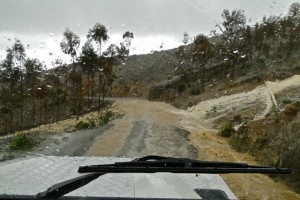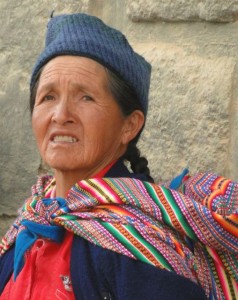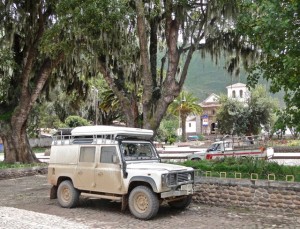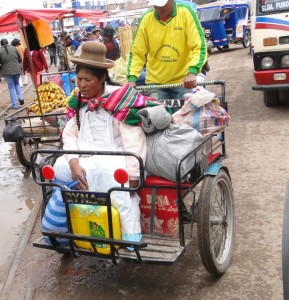At last we have found a city we like. But it’s not in Peru. It’s La Paz, Bolivia. And truth be told, we’re actually in love with a barber there. More about him in a moment. Right now, I want to tell you about my most traumatic day on the trip so far.
It began happily enough, with us having the entire Inca ruins of Pisac to ourselves for 2 hours on a sunny morning. That no one else was there is thanks to the bridge between Cusco and Pisac still being closed as a result of the devastating rains that also wrecked the rail lines to Machu Picchu in December. As we needed to head east, and couldn’t take the normal short route through Cusco (Brunhilde didn’t ship with water wings), we were forced into the high country once again. Which is our preference anyway. I had a brief palaver with some bus drivers at the Pisac parking lot, adding some persuasiveness on my part that indeed a road did exist where we wanted to go and, yes, we would be able to manage the curves, before they finally pointed out the road we wanted. For awhile it was a fair romp over the good dirt roads, except we were driving under ever darkening skies. Literally around a bend high in the altiplano we entered a torrential rain storm. Red rivulets poured down the hills, joining to form pulsing streams and cascades which leapt onto the road, flooding ditches and swamping the byways, gathering force as they raced down the next hill.
The road was awash, villagers in plastic ponchos desperately building crude rock diversions to keep water from coursing into their homes. The only thing running through my head was “This is how landslides start.” Any minute I expected to see earth moving or worse yet, feel it sliding under us, carrying us off the road and down the mountain. With no sympathy whatsoever, Bernard insisted we stop the car and photograph what the scene looked like (see attached). Since at the time it was all I could do to keep myself breathing I was unable to open my mouth and protest that we really should drive as fast as possible out of there, photos be damned.
Finally, to my huge relief, we did exit the storm area entirely. My happiness was short-lived, because almost immediately we found ourselves on a partially constructed highway cutting across the slope of a huge mountain. The surface alternated between broad flat open courseways wide enough for two semis, to rocky 1-lane constrictions. At one of the latter, we were forced to back-up to let an uphill bus pass. Bernard started to reverse but with the windows and mirrors lathered in red mud, he couldn’t see. Turning to his trusty navigator, he said, “I need you outside to guide me.” I opened my door and was about to step out when I realized there was only air beneath me. He’d backed so close to the edge that the only solid thing between me and the valley floor thousands of feet down was the running board. In a fit of atavistic inspiration so swift I couldn’t detect my brain giving instructions, my body launched itself leftward as far from the door as possible. “I can’t get out!” I yelled at Bernard, who of course was dumbfounded, because he’d seen me open the door. “There’s no ground there!!” I screamed at him. This, too, made no sense to him. I wasn’t able to find the words to further clarify the situation, but I knew one thing. Sometimes, one has to put one’s foot down and in this case, the one place I was willing to put mine was on the car floor.
We spent a couple of days in Puno on the shores of Lake Titicaca. Our first night there, we witnessed the final dance night of Carnaval. About 50 dance clubs, all dressed the same and each with their private band, performed two classic dances around the main plaza. It was a beautiful sight, with the Aymara women dressed in jewel-colored knee length flouncy skirts, brilliantly embroidered shawls draped over their white shirtwaists, ridiculously tiny dress bowler hats perched at a jaunty angle on their long black braids. Their partners wore square-cut black jackets, loose trousers and a classic fedora, with a long-fringed damask satin shawl in every pastel shade tied around their shoulder. Each club twirled matching satin kerchiefs as they promenaded in front of the cathedral, trumpets, accordions and saxophones blaring, the men nodding coyly to their partners, the women tossing their heads coquettishly in response. We followed this with a restorative class of hot tea with a shot of pisco at a nearby bar.
Titicaca is shared between Peru and Bolivia, and is surrounded by villages some of which are Quechua descended from the Inca, others Aymara, who pre-date the Inca. I asked a young Titicacan woman how I might tell a Quechua from an Aymara. She cupped her hands and began patting them together as if making a meatball, then with her index finger and thumb she poked and pinched that imaginary ball until it was dented and squushed. Holding her cupped hands up to me she said, “Quechua, they have small, round faces,” and she scrunched her own face up until she looked like a dried-apple doll. Then she described a perfect oval with her hands. “Aymara have long, elegant faces.” Using her fingers, she drew a graceful oval around the contours of her face. “I,” she said, “am Aymara.”
We visited a church in the little village of Chucuito near Puno. I’ve seen a lot of old churches and moldy virgins in my day, but this particular church had the most beautiful Virigin Mary I’ve seen. The guardian explained she’d been carved in 1545 by one of f Spain’s best sculptors. And then, slyly, he told us that under her exquisite white and gold satin dress her entire body was carved and painted. Feeling I had nothing to lose, I asked if he’d show us, knowing full-well he wouldn’t. To my profound amazement, he not only said Yes, but said Bernard could photograph her. Then, in the most sacriligious act I’ll ever witness, he lifted her skirts in front of a man! Really, this is not supposed to be done. Expecting to be promptly struck by something or other I did a little dance around the old stone floor hoping that if I kept moving the lightening bolt sent by celestial beings would miss. Even so, I can tell you that naked virgin was magnificent, with twin cherubs at her feet and the draping of her garments carved and painted in green and gold.
Beginning of March we left Peru for Bolivia, crossing the border at Desaguadero on Titicaca’s eastern shore. I love borders. They’re such fascinating, unpredictable places, revealing all the idiosyncracies and tensions of two countries. And this one, being a known blackmarket and smugglers town, was even more interesting. We wended our way through packed streets (it was market day….good timing!), to the border gates, where long cues awaited us. Despite having to visit three separate offices to exit Peru (passport, car, police), things moved smoothly.
Within an hour we drove under the big Welcome to Bolivia sign, and had our first encounter with Bolivian military police. These two men in green fatigues were puffed up with self-importance, despite–or, in retrospect, because of–the fact they were just glorified parking lot attendants, charged with pointing out where crossing vehicles had to park. As is my job, I jumped out and asked them which building I should go to first. The one with the gold teeth and evil black eyes gave a dismissive wave which included every building in sight. Turning to his comrade he spat out of the side of his mouth and said, “This is one mixed up lady. Let’s see what mistakes she makes.” Having understood exactly what he’d so smugly said, I was sorely tempted to give a rejoinder like, “I’m not the only one here who can’t figure anything out.” Thankfully, in the time it took me to figure out how to say this properly in Spanish, I also realized that it would be a shame to be kicked out of Bolivia when I was barely even in the country or, worse yet, to spend my visit there inspecting the dank walls of a border jail cell. I bit my tongue and took a lucky guess as to which building to go. Another hour and we were on our way. The rains of Peru were left behind and the sun shone all the way to La Paz. I was using a new map and everything about our trip felt fresh again.
And now, briefly, about Isaac Soliz Brant Arroyo, the Barber of La Paz. We met Isaac after doing some travel tasks in the center of La Paz. “You need a haircut,” I said to Bernard, for probably the tenth time on this trip. “I know, I know, maybe tonight,” he muttered (we travel with hair clippers). “Let’s find a barber shop,” I suggested brightly, though with little hope. But there at the back of the building we were in, was a beauty salon. “How about that?” I asked, gesturing to the room full of ladies. No go. And then we noticed, in an ill-lit corner, a sign saying Peluqueria Caballeros….barber shop! It was empty except for the barber’s chair, a shelf of cutting tools, and a beautiful gold-filigreed clock. It was a shop that clearly had seen better times.
In we went and the barber got up to greet us, folding his daily newspaper on the chair. Small, a bit round-shouldered, with neatly coiffed dyed hair that was a little too blue to be true and, naturally, well-shaven, he toddled toward us and asked how he might help. I requested a hair cut and Bernard got into the chair. Changing from his tattered sweater into a proper white coat, he swaddled Bernard in a white gown, and then plugged in a mini-jackhammer with which he gave Bernard a shoulder massage. He sterilized all his implements and combs as a barber would have a century-ago, pumping ether onto each and setting them alight. Then he began to snip, feather and comb, giving Bernard the first proper haircut he’s had in years. Lastly he spread warm lather on Bernard’s neck and cheeks, stropped his German-made straight razor on balsa wood and leather, and shaved all the scraggly bits. As Bernard was getting the treatment I read a framed article on the barbershop wall and thus learned that Isaac Soliz had shaved both Nixon AND Che Guevara. Now that’s something to conjure with. The closest those two men ever came was having the same scissors and razor touch their hair. Mr. Soliz is 90, hands steady as a rock, works 7 days a week, and has made the 30-hour walk to pay his respects to the Virgin of Copacabana every year until he was 88. We spent the better part of the afternoon with him, and it’s been one of the highlights of our trip.
And now, one bit of bad news. So far on this trip I’ve been delirious that we’re finally in a vehicle suitable for the places we want to go. Brunhilde’s been a real treat, roomy, rugged and resourceful. On our second day in La Paz, we drove into the hills to visit Coroico, a village that’s in the warm and luscious cloud forest. The way out was highway, and we drove through rain and fog as thick as quilt batting. When we found a dirt road to short cut the way back, we took it, climbing through stages of jungle with, finally, magnificent views. Forty minutes in and we were brought up short by an immense landslide. At first we thought Brunhilde could make it, but after walking 50 yards, we found large boulders strewn across the way like a giant’s marble game. Time to turnaround and go back, something I didn’t regret because it gave me a second chance to see the purple orchids and iridescent blue 5-inch butterflies I’d noticed on the way up. Unfortunately, as we drove down, we started hearing a clanking noise. Clanking isn’t good, not on a new car, and this one was a particular mystery, only becoming audible to us at 45kph. We stopped twice to try to uncover how the sound was being created with no success. The noise was so loud that roadside vendors would jump out of the way and frown at us when we drove by. Back in La Paz, we were fortunate our hotel was 5 blocks from an excellent repair shop, where the owner was willing to put Brunhilde on a lift immediately.
The noise was tracked to the rear differential and here’s how Bernard describes the problem: “5 of the 8 bolts holding the planetary gears assembly were most likely never torqued properly and backed-out of their threads. The bolt heads quickly gouged the diff housing and the part holding the ball bearings. Fortunately, the bolts bent but did not shear. But the walls of the part which holds the ball bearing in place are now pretty thin, a millimeter rather than the half-inch that’s normal.” Here’s how I describe what happened, “We’re totally fucked.” Three hours and 6 mechanics later, the part was repaired. But now, once again, every time I get into the car, I can’t help but think this’ll be the day we break down in the middle of nowhere and I have to come to terms with living on energy bars and Jolly Ranchers for weeks while Bernard goes off to try to find a way to get our car hauled out of whatever desert we’re marooned in. Travelling in Brunhilde I felt car confident for the first time and had put all my car worries behind me. Really, I’ve been doing so well in the anxiety department, confining my worries to small things like landslides and falling off cliffs. And now this…….
OK, enough. We’re still moving and next missive you’ll find some actual reflections on Bolivia.
-Dina














